802.11r WiFi roaming configuration example: Difference between revisions
No edit summary |
No edit summary |
||
| Line 17: | Line 17: | ||
==Configuration== | ==Configuration== | ||
[[File:Networking rutos configuration examples wifi roaming configuration scheme v2.png|border|class=tlt-border]] | [[File:Networking rutos configuration examples wifi roaming configuration scheme v2.png|800px|center|border|class=tlt-border]] | ||
===Gateway router=== | ===Gateway router=== | ||
| Line 29: | Line 29: | ||
</ol> | </ol> | ||
</ol> | </ol> | ||
[[File:Networking rutx50 webui lan configuration v2.png|border|class=tlt-border]] | [[File:Networking rutx50 webui lan configuration v2.png|800px|center|border|class=tlt-border]] | ||
Navigate to the '''Network → Wireless → SSIDs''' page. Configures as follows: | Navigate to the '''Network → Wireless → SSIDs''' page. Configures as follows: | ||
| Line 38: | Line 38: | ||
<li>Enable '''802.11r Fast Transition'''</li> | <li>Enable '''802.11r Fast Transition'''</li> | ||
</ol> | </ol> | ||
[[File:Networking rutx50 webui wirless ssid configuration v1.png|border|class=tlt-border]] | [[File:Networking rutx50 webui wirless ssid configuration v1.png|800px|center|border|class=tlt-border]] | ||
Navigate to the '''Fast Transition''' section | Navigate to the '''Fast Transition''' section | ||
| Line 45: | Line 45: | ||
<li>Enter '''Mobile Domain''': 4f57 ()</li> | <li>Enter '''Mobile Domain''': 4f57 ()</li> | ||
</ol> | </ol> | ||
[[File:Networking rutx50 webui wireless ssid 802.11r FT configuration v1.png|border|class=tlt-border]] | [[File:Networking rutx50 webui wireless ssid 802.11r FT configuration v1.png|800px|center|border|class=tlt-border]] | ||
To reduce the posbility of interference between 2 AP/WiFi Router, Highly recommend that set radio channel manually. | To reduce the posbility of interference between 2 AP/WiFi Router, Highly recommend that set radio channel manually. | ||
| Line 52: | Line 52: | ||
<li>Select '''Channel''': 11</li> | <li>Select '''Channel''': 11</li> | ||
</ol> | </ol> | ||
[[File:Networking rutx50 webui wireless radio channel configuration v1.png|border|class=tlt-border]] | [[File:Networking rutx50 webui wireless radio channel configuration v1.png|800px|center|border|class=tlt-border]] | ||
===AP/WiFi Router=== | ===AP/WiFi Router=== | ||
| Line 59: | Line 59: | ||
<li>Enter '''IPv4 address''': 192.168.1.2 (On router 3, enter 192.168.1.3)</li> | <li>Enter '''IPv4 address''': 192.168.1.2 (On router 3, enter 192.168.1.3)</li> | ||
</ol> | </ol> | ||
[[File:Networking rutx11 webui lan configuration v1.png|border|class=tlt-border]] | [[File:Networking rutx11 webui lan configuration v1.png|800px|center|border|class=tlt-border]] | ||
Navigate to the '''Network → DHCP → Sever Setting''', configures as follows: | Navigate to the '''Network → DHCP → Sever Setting''', configures as follows: | ||
| Line 66: | Line 66: | ||
<li>Enter '''DHCP Server''' 192.168.1.1 (Gateway router is also the DHCP server for all internal devices)</li> | <li>Enter '''DHCP Server''' 192.168.1.1 (Gateway router is also the DHCP server for all internal devices)</li> | ||
</ol> | </ol> | ||
[[File:Networking rutx11 webui dhcp server setting relay configuration v1.png|border|class=tlt-border]] | [[File:Networking rutx11 webui dhcp server setting relay configuration v1.png|800px|center|border|class=tlt-border]] | ||
Navigate to the '''Network → Routing → Static routes''', add one default routing to gateway routing. Configures as follows: | Navigate to the '''Network → Routing → Static routes''', add one default routing to gateway routing. Configures as follows: | ||
| Line 72: | Line 72: | ||
<li>Add 0.0.0.0/0 static route to gateway IP 192.168.1.1 with matrix 1, select '''Route Type''' to unicast</li> | <li>Add 0.0.0.0/0 static route to gateway IP 192.168.1.1 with matrix 1, select '''Route Type''' to unicast</li> | ||
</ol> | </ol> | ||
[[File:Networking rutx11 webui route default routes configuration v1.png|border|class=tlt-border]] | [[File:Networking rutx11 webui route default routes configuration v1.png|800px|center|border|class=tlt-border]] | ||
Navigate to the '''Network → Wireless → SSIDs''', configures as follows: | Navigate to the '''Network → Wireless → SSIDs''', configures as follows: | ||
| Line 80: | Line 80: | ||
<li>Enter '''Password''' (Same as gateway's SSID password)</li> | <li>Enter '''Password''' (Same as gateway's SSID password)</li> | ||
<li>Enable '''802.11r Fast Transition'''</li> | <li>Enable '''802.11r Fast Transition'''</li> | ||
[[File:Networking rutx11 webui wirless ssid configuration v1.png|border|class=tlt-border]] | [[File:Networking rutx11 webui wirless ssid configuration v1.png|800px|center|border|class=tlt-border]] | ||
Navigate to the '''Fast Transition''' section | Navigate to the '''Fast Transition''' section | ||
Revision as of 07:51, 26 September 2024
Introduction
This article provides a basic configuration example of 802.11r WiFi roaming.
Firmwware
The information in this page is updated in accordance with 00.07.09 firmware version. .
Prerequisites
- Main gateway with WAN access (Any RUTOS router. RUTX50 is used in this example)
- Access Points (Any WiFi-capable RUTOS device. RUTX11 (Router 1) and RUTX11 (Router 2) are used in this example)
Before you start configuring the router turn on "Advanced WebUI" mode. You can do that by clicking the "Basic" button under "Mode", which is located at the top-right corner of the WebUI.
Configuration
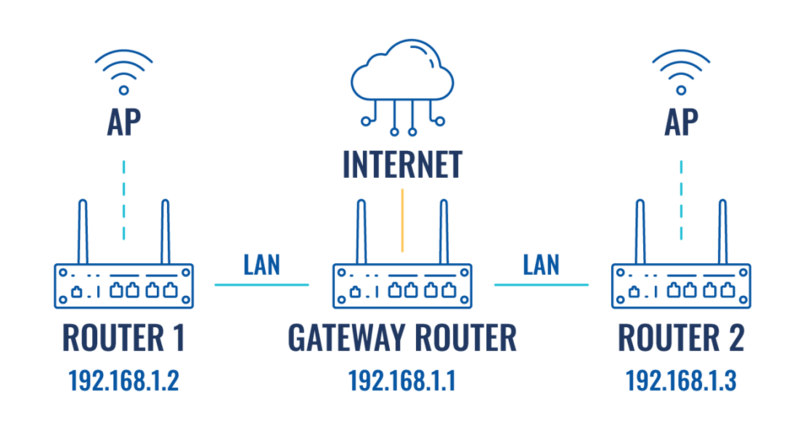
Gateway router
Login to the router's WebUI, navigate to the Network → Interfaces → Edit LAN page. Enter main gateway's IP address and save. We will leave it default (192.168.1.1) for this example. Enter IP address on the same subnet as main gateway. We will use 192.168.1.2 for Router 1 and 192.168.1.3 for Router 2 in this example.
- Connect your AP/WiFi router to the gateway router using LAN to LAN connection.
- Login to the router's WebUI, navigate to the Network → Interfaces → Edit LAN page. Configure as follows:
- Enter IPv4 address. We will use our gateway router's IP - 192.168.1.1.

Navigate to the Network → Wireless → SSIDs page. Configures as follows:
- Select radios to 2.4Ghz
- Enter SSID: WiFi_Roaming
- Enter Password
- Enable 802.11r Fast Transition
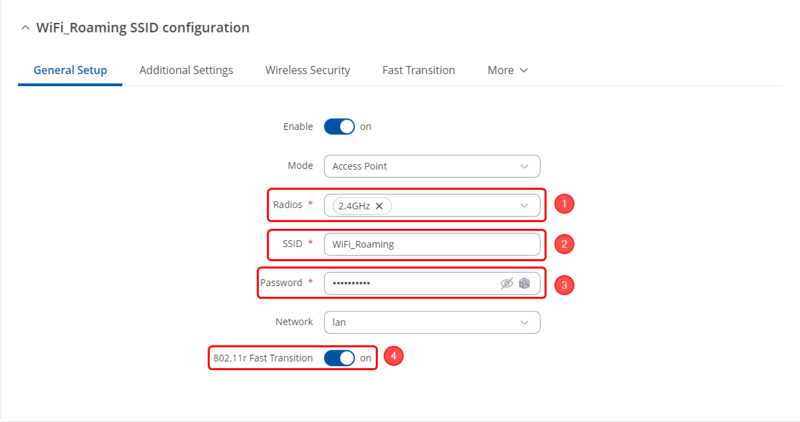
Navigate to the Fast Transition section
- Enter NASID: 1 (Nas ID of each device must be unique)
- Enter Mobile Domain: 4f57 ()
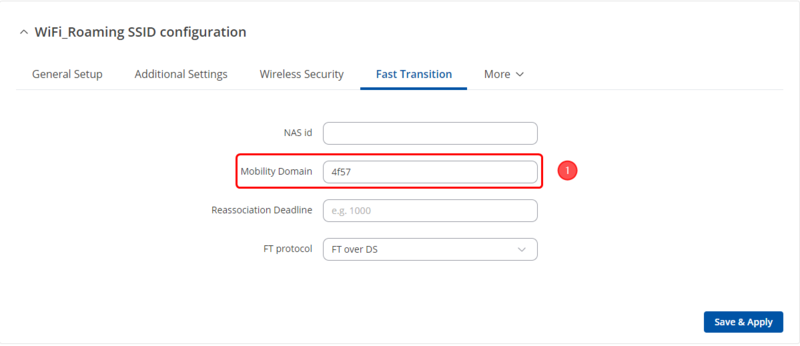
To reduce the posbility of interference between 2 AP/WiFi Router, Highly recommend that set radio channel manually. Navigate to the Network → Wireless → Radio → Edit 2.4GHz. Configures as follows:
- Select Channel: 11
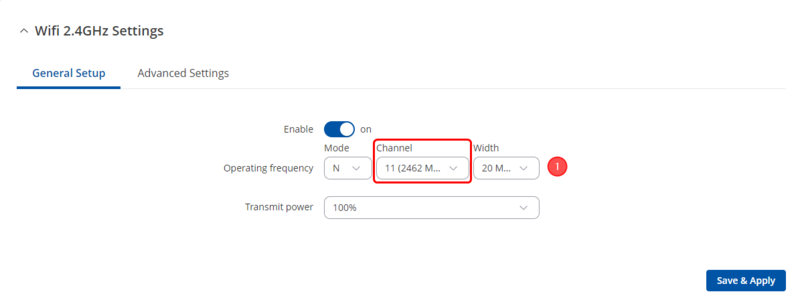
AP/WiFi Router
Navigate to the Network → Interfaces → Edit LAN, Configures as follows:
- Enter IPv4 address: 192.168.1.2 (On router 3, enter 192.168.1.3)
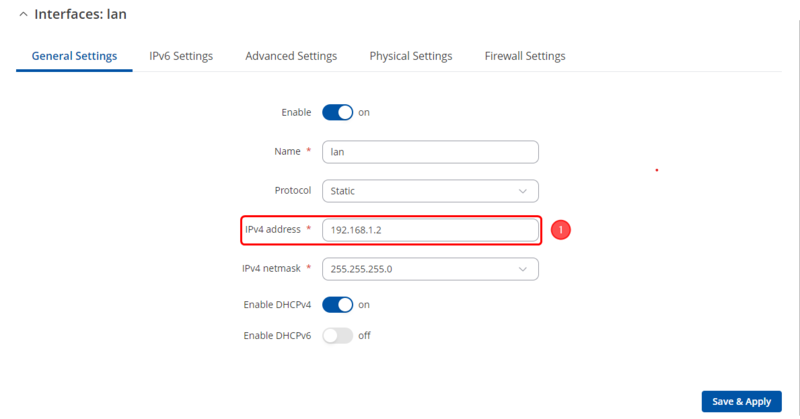
Navigate to the Network → DHCP → Sever Setting, configures as follows:
- Select DHCPv4 Mode to Relay
- Enter DHCP Server 192.168.1.1 (Gateway router is also the DHCP server for all internal devices)
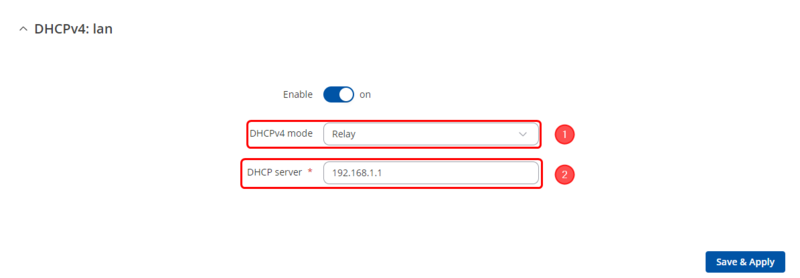
Navigate to the Network → Routing → Static routes, add one default routing to gateway routing. Configures as follows:
- Add 0.0.0.0/0 static route to gateway IP 192.168.1.1 with matrix 1, select Route Type to unicast
Navigate to the Network → Wireless → SSIDs, configures as follows:
- Select radios to 2.4Ghz
- Enter SSID: WiFi_Roaming (Same as gateway's SSID)
- Enter Password (Same as gateway's SSID password)
- Enable 802.11r Fast Transition
- Enter NASID: 2 (On router 3, enter 3)
- Enter Mobile Domain: 4f57 (Keep same as gateway router's setting)
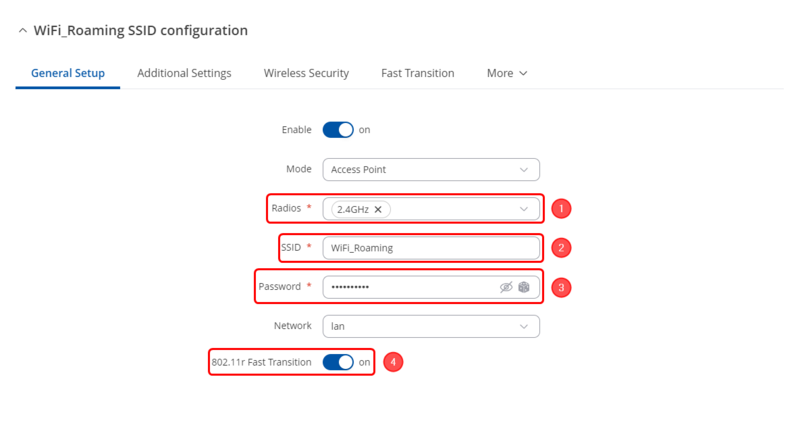
Navigate to the Fast Transition section
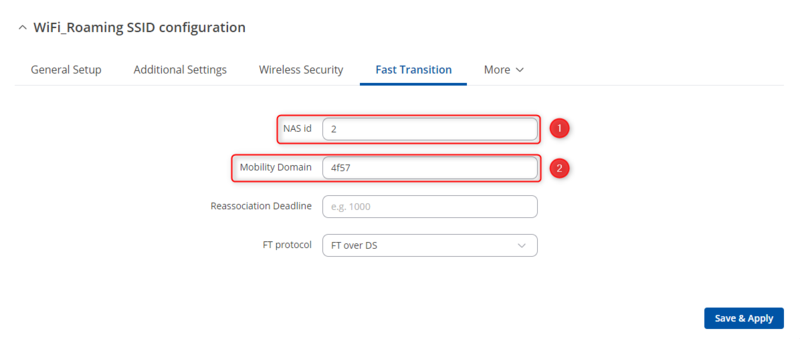
Result
The single AP should now be visible on your WiFi devices (an iOS phone is used in this example).

